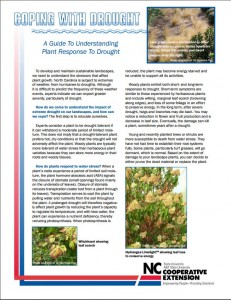Coping With Drought
go.ncsu.edu/readext?431935
en Español / em Português
El inglés es el idioma de control de esta página. En la medida en que haya algún conflicto entre la traducción al inglés y la traducción, el inglés prevalece.
Al hacer clic en el enlace de traducción se activa un servicio de traducción gratuito para convertir la página al español. Al igual que con cualquier traducción por Internet, la conversión no es sensible al contexto y puede que no traduzca el texto en su significado original. NC State Extension no garantiza la exactitud del texto traducido. Por favor, tenga en cuenta que algunas aplicaciones y/o servicios pueden no funcionar como se espera cuando se traducen.
Português
Inglês é o idioma de controle desta página. Na medida que haja algum conflito entre o texto original em Inglês e a tradução, o Inglês prevalece.
Ao clicar no link de tradução, um serviço gratuito de tradução será ativado para converter a página para o Português. Como em qualquer tradução pela internet, a conversão não é sensivel ao contexto e pode não ocorrer a tradução para o significado orginal. O serviço de Extensão da Carolina do Norte (NC State Extension) não garante a exatidão do texto traduzido. Por favor, observe que algumas funções ou serviços podem não funcionar como esperado após a tradução.
English
English is the controlling language of this page. To the extent there is any conflict between the English text and the translation, English controls.
Clicking on the translation link activates a free translation service to convert the page to Spanish. As with any Internet translation, the conversion is not context-sensitive and may not translate the text to its original meaning. NC State Extension does not guarantee the accuracy of the translated text. Please note that some applications and/or services may not function as expected when translated.
Collapse ▲ Quick Tips:
Quick Tips:
-
-
-
- Plants response to short-term drought: wilting, marginal leaf scorch (browning along edges), and loss of some foliage.
-
- Plants response to long-term drought: twigs and branches may die back, reduction in flower and fruit production, decrease in leaf size and eventually death.
- Young and newly installed plants are most vulnerable.
- Insects and diseases may attack drought stressed plants.
- Design your landscape for resilience. Select plants that will thrive in light, soil, space and hardiness zone provided by your yard.
- Scout for insects or disease problems and address quickly.
- Apply organic mulch.
- Aerate turf and cut at highest setting for that variety.
-
- More information


